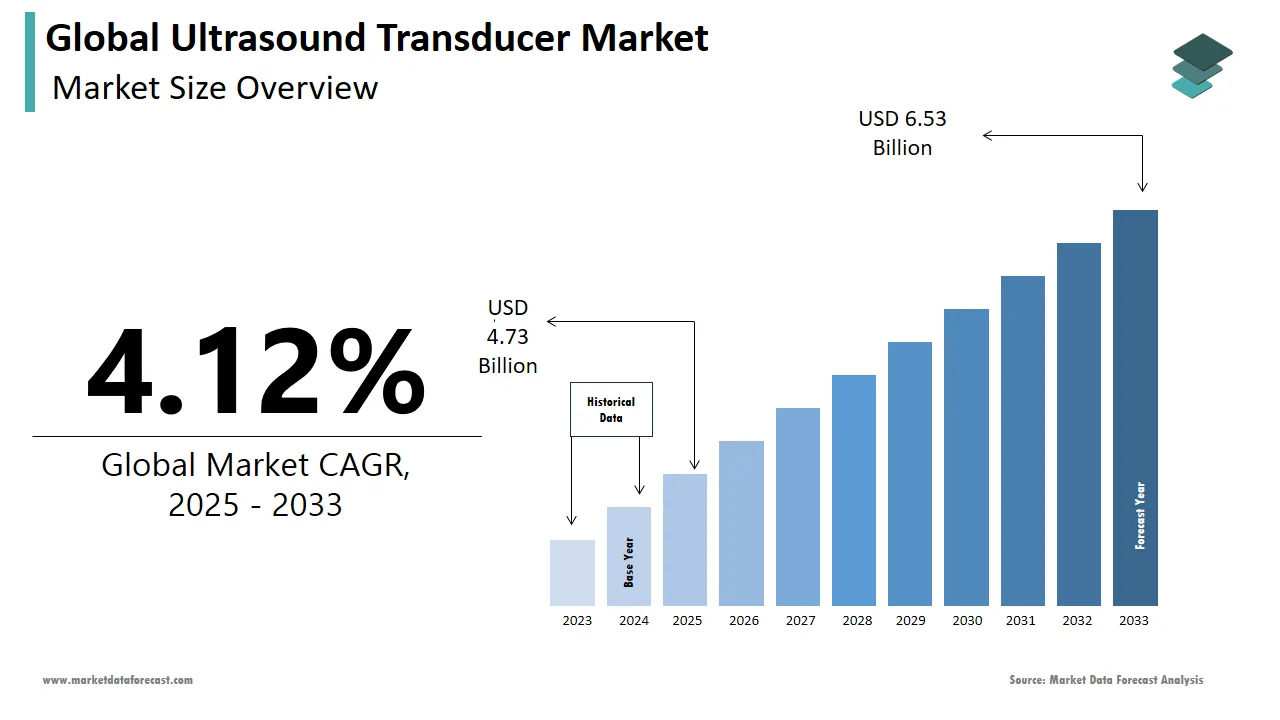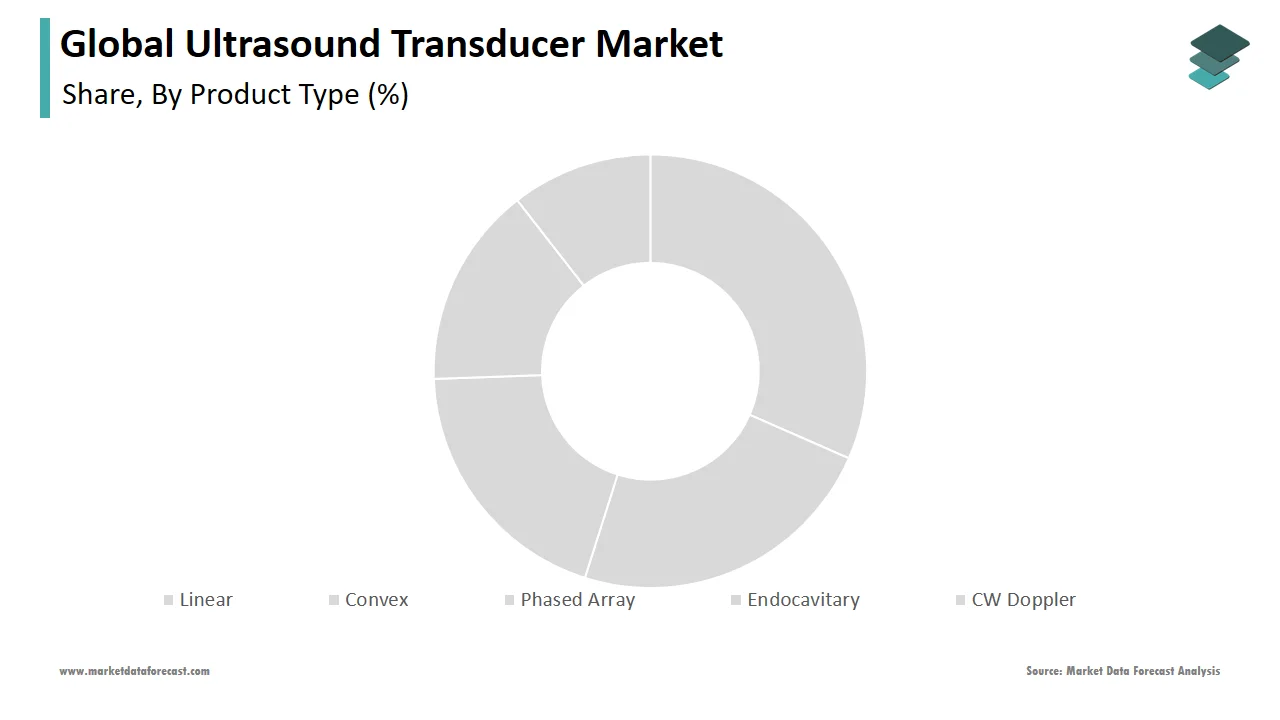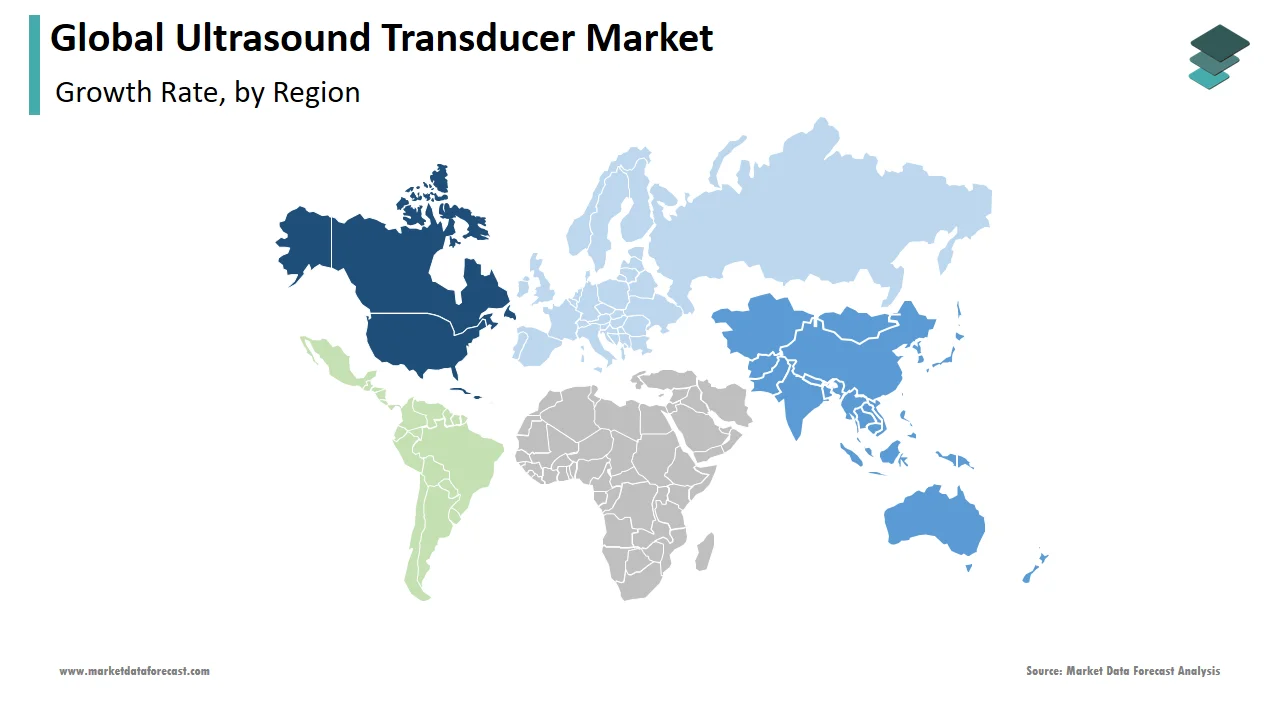Global Ultrasound Transducer Market Ultrasound Transducer Market By Product Type, Application, End-Use and Region (North America, Europe, Asia-Pacific, Latin America, Middle East and Africa), Industry Analysis From 2025 To 2033.
Global Ultrasound Transducer Market Size
The size of the global ultrasound transducer market was worth USD 4.54 billion in 2024. The global market is anticipated to grow at a CAGR of 4.12% from 2025 to 2033 and be worth USD 6.53 billion by 2033 from USD 4.73 billion in 2025.

Ultrasound is a type of medical imaging that uses high-frequency sound waves to visualize the body's inside organs. These ultrasonic waves are subsequently reflected into the probe by the body organs and sent to a display unit, which generates an image and echoes. The ultrasonic transducer helps determine the precise position of an object by estimating the distance from the object's source echo. With transducers, ultrasound technology transfers ultrasound waves and transmits images with echoes in the machine. These are used for cardiac, abdominal, cerebrovascular, gynecological, and urological monitoring, among other things. Ultrasound transducers function in the same way that sonar or radar does.Ultrasound transducers generate sound waves that bounce off of biological tissue and organs, resulting in echoes. The transmitter, receiver, and trans-receiver are the three parts of an ultrasound transducer. The echoes are received by the transducer and sent to the computer, creating a sonogram, an image of the echoes. These transducers contain one or more piezoelectric crystals, which are quartz crystals. These crystals change shape when an electric current passes through them. Sound waves are created when the shape of the object changes. Cardiac ultrasound transducers are available in a variety of sizes and forms.
MARKET DRIVERS
The growth of the global ultrasound transducer market is expected to be driven by the increasing target patient pool and technological advancements related to transducers.
Furthermore, an increase in the number of people with chronic diseases increased awareness about early detection. As a result, the number of ultrasound diagnostic imaging operations is all driving the ultrasound transducer market forward. In addition, a wide range of ultrasound transducer applications and increased demand for portable and ultraportable diagnostic ultrasound systems in gynecology and obstetrics are driving the ultrasound transducers market.Companies launch ultrasonic devices with an internal security alarm system enabled by Bluetooth wireless radio and a sophisticated transducer to maintain probe location security. These advanced items were created with several purposes in mind, including vascular and musculoskeletal issues. In addition, new devices such as the SiliconWave L38-22 linear transducer, EPIQ Elite ultrasound system, and mi-ultra with linear and convex widths are expected to accelerate the market growth. The global ultrasound transducers market is likely to develop due to the rising use of ultrasonic systems due to their high efficiency and safety. In addition, these devices give an accurate diagnosis, enable physicians to provide effective imaging to improve patient care with fewer overhead and expenses, and provide doctors with real-time data for better diagnosis. Because of these benefits, the demand for ultrasonic systems is increasing, which is expected to boost the global ultrasound transducers market.
MARKET RESTRAINTS
The global ultrasound transducer market is expected to be restricted by the technological limits of ultrasound transducer systems and a lack of experience and skilled sonographers. Ultrasound Transducer necessitates professional sonographers to get a reliable, artifact-free recording with high clinical and diagnostic value. In addition, a qualified sonographer is required to use an ultrasound transducer to acquire images in real-time that depict the structure and movement of internal human organs and blood flow through blood arteries.
REPORT COVERAGE
|
REPORT METRIC |
DETAILS |
|
Market Size Available |
2024 to 2033 |
|
Base Year |
2024 |
|
Forecast Period |
2025 to 2033 |
|
CAGR |
4.12% |
|
Segments Covered |
By Product, Application, End-User, and Region. |
|
Various Analyses Covered |
Global, Regional, and country-level analysis; Segment-Level Analysis, DROC; PESTLE Analysis; Porter’s Five Forces Analysis, Competitive Landscape; Analyst Overview of Investment Opportunities |
|
Regions Covered |
North America, Europe, APAC, Latin America, Middle East & Africa |
|
Market Leaders Profiled |
General Electric Company, Koninklijke Philips N.V., Shenzhen Mindray Bio-Medical Electronics Co., Ltd., Fujifilm Corporation, Samsung, Siemens Healthineers AG, Hitachi, Ltd., ESAOTE SPA, SIUI, and Shenzhen Ruqi Technology Co., Ltd., and Others. |
SEGMENTAL ANALYSIS
By Product Type Insights

Because of its great efficiency, the convex segment dominates the global ultrasonic transducers market during the forecast period. Unlike a linear array setup, it has a larger footprint and focuses the view on the deepest section of the targeted region. It also provides a crisper image with more dependability. The need for a convex scanning transducer is expected to increase as a result of these causes. Because the arrangement of piezoelectric crystals is curving, convex transducers are also known as curved transducers (rounded). The form of the beam is suitable for in-depth research. Furthermore, the widespread use of convex transducers in diagnosing transvaginal, abdominal, and transrectal conditions is estimated to encourage segment expansion.
By Application Insights
Due to an increase in demand for accurate diagnostic choices, the development of mainly developed devices, increased prevalence of heart problems, and growing awareness among individuals regarding prompt treatment, the cardiovascular segment is predicted to grow at the quickest rate.
By End-user Insights
Due to the significant adoption of ultrasound systems as the primary imaging option, the hospital segment is expected to lead the global ultrasound transducer market during the forecast period. Other driving factors affecting the segment's growth include an increase in skilled personnel in hospitals and a growing awareness of innovative equipment.
REGIONAL ANALYSIS

Because of the widespread use of ultrasonography in general diagnostics and the increased frequency of lifestyle-related chronic diseases, North America is expected to lead the global ultrasound transducer market during the forecast period. In addition, the region's market is predicted to grow due to the high demand for technologically improved medical equipment. In the North America area, the United States holds the highest share of the Ultrasound Transducer Market. Furthermore, the region's well-established infrastructure and rising healthcare infrastructure are likely to fuel the Ultrasound Transducer Market.
Due to the availability of sophisticated health care infrastructure, rising cases of chronic disorders, and increasing demand for advanced ultrasound equipment in the region, Europe is expected to grow rapidly during the projection period. On the other hand, due to the cost-effectiveness of ultrasound equipment, increasing healthcare facilities, and the frequency of heart disease, the Asia-Pacific market is predicted to grow at the quickest rate. The market for cardiac ultrasound transducers or probes is expected to rise in this region due to the development of portable and hand-held ultrasound devices and their low cost.
KEY MARKET PLAYERS
General Electric Company, Koninklijke Philips N.V., Shenzhen Mindray Bio-Medical Electronics Co., Ltd., Fujifilm Corporation, Samsung, Siemens Healthineers AG, Hitachi, Ltd., ESAOTE SPA, SIUI, and Shenzhen Ruqi Technology Co., Ltd. are a few of the promising companies in the global ultrasound transducer market profiled in this report.
RECENT MARKET HAPPENINGS
- The new Sonosite PX ultrasound system launched in July 2020, according to FUJIFILM Sonosite, Inc. Sonosite PX is the next version of Sonosite POCUS, offering the highest image clarity of any Sonosite system.
- The ultrasound solution for pediatric patient assessment, the latest addition to Koninklijke Philips N.V.'s Philips Ultrasound System, will be available in May 2020. (EPIQ Elite). By avoiding additional diagnostic imaging stages, the technology allows clinicians to diagnose pediatric patients.
MARKETSEGMENTATION
This research report on the global ultrasound transducer market has been segmented and sub-segmented based on product type, application, end-user, and region.
By Product Type
- Linear
- Convex
- Phased Array
- Endocavitary
- CW Doppler
By Application
- Cardiovascular
- General Imaging
- Musculoskeletal
- OB/GYN
- Vascular
By End-user
- Hospital
- Clinics
- Diagnostic center
- Ambulatory Surgery Centers
By Region
- North America
- Asia Pacific
- Europe
- Latin America
- The Middle East and Africa
Related Reports
Access the study in MULTIPLE FORMATS
Purchase options starting from $ 2500
Didn’t find what you’re looking for?
TALK TO OUR ANALYST TEAM
Need something within your budget?
NO WORRIES! WE GOT YOU COVERED!
Call us on: +1 888 702 9696 (U.S Toll Free)
Write to us: [email protected]
